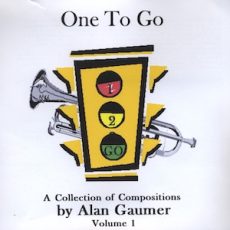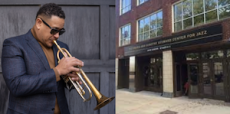
DUANE EUBANKS QUARTET
Duane Eubanks was raised in a musical family, but stopped playing in his teens and instead pursued a degree in accounting; six years later, he conceded that this had been an error, and returned to music. He subsequently studied jazz at Temple University, where he played with Wynton Marsalis and Billy Taylor, and also spent two years training with Johnny Coles.
He hass released his first album, My Shining Hour, in 1999, having been approached by a producer who had heard him performing on his brother Robin’s album 4: JJ / Slide / Curtis and Al. In 2002 and 2005, Eubanks shared in the Grammy Awards received by Dave Holland’s big band for the albumsWhat Goes Around and Overtime.
Showtime: 7:00pm
Cover: $25.00
More Posts: adventure,bandleader,club,genius,instrumental,jazz,music,preserving,travel,trumpet

Daily Dose Of Jazz…
Alan Gaumer was born on July 25, 1951 in Bethelehem, Pennsylvania. He began playing the trumpet when he was eight and was a member of Kal’s Kid’s that appeared on the Ted Mack Original Amateur Hour as well as numerous other television shows. Throughout elementary, junior and high school he participated in band, orchestra, and stage bands and graduated from Freedom High School in 1969.
He studied with John Nero and Willard Schissler and performed with the Allentown Band before attending the U.S. Navy School of Music. Upon graduation he spent the next three years living in Gaeta, Italy touring Europe, Africa and Asia with the Navy Show Band. Offered the jazz trumpet position at the U.S. Naval Academy in Annapolis before his discharge, from 1973-75 he toured first as trumpeter and later as drummer with the well known group KATO.
Settling back in the Lehigh Valley, Pennsylvania he was an integral part of a popular group P.F. & the Flyers and his own A.G.Q. After attending Rutgers University, Alan spent two years touring South America and West Africa with the U.S. Navy Show Band. When he got out in 1982, he worked for several years at well known hotels and resorts.
He has performed with a long list of jazz musicians which include Randy Brecker, Phil Woods, Al Cohn, George Young, Bob Dorough, Tom Harrell, Bill Watrous, Urbie Green, Kim Parker, Vic Jurris, Charles Fambrough, Bill Washer, John Swanna, David Leonhardt, Steve Gilmore, Bill Goodwin, Bobby Routch, Tom Schuman of Spyro Gyra and others.
As an educator Gaumer has been the jazz trumpet Artist/Lecturer at Moravian College since 1994 and served as Fusion ensemble director in 1998-99, 2003-04 and 2005-06. He is Artistic Director of the Pennsylvania Jazz Collective, a Lehigh Valley based non-profit jazz organization.
Trumpeter and educator Alan Gaumer continues to perform, teach and produce jazz events.
More Posts: bandleader,educator,history,instrumental,jazz,music,trumpet

MARQUES CARROLL QUINTET
Trumpeter Marques Carroll, brings his Chicago based quintet to St. Louis for a two night gig, featuring Greg Artry ~ drums, Julius Tucker ~ piano, Christian Dillingham ~ bass, and Marvin Truong ~ alto saxophone. The St. Louis native is an Emmy Award winner, Grammy member, jazz educator, and former member of the legendary Count Basie Orchestra.
Blending fiery original compositions with contemporary classics by Roy Hargrove, Wayne Shorter, and others, the group brings a message-driven sound shaped by social justice, personal heritage, and artistic integrity. From his debut, The Ancestors’ Call, to his follow-up Foundations, Carroll crafts music that honors legacy while pushing toward progress. Together, this ensemble of bandleaders delivers a bold and deeply expressive voice, refined in Chicago, and resonating far beyond.
Cover: Sold Out
More Posts: adventure,bandleader,club,genius,jazz,music,preserving,travel,trumpet

RANDY BRECKER
Randy Brecker with Tod Dickow and Charged Particles
Winner of 15 Grammy Awards, Michael Brecker’s unique voice and approach to the tenor saxophone influenced every saxophonist playing jazz today. The jazz world lost him in 2007 at the age of 57. In honor of Michael Brecker, Charged Particles recorded a live CD of his music which was included on “Best Of” lists in JazzTimes magazine, Jazzwise magazine, All About Jazz, The Mercury News, Glide Magazine, the Jazz Journalists Association Poll, and the Jazz Critics Poll.
Michael Brecker’s biographer, Bill Mikowski, said that the performance is “staggering in its authenticity.” And Downbeat magazine said they play “exciting, satisfying stuff.” The band’s sold-out performances at the landmark jazz clubs Ronnie Scott’s in London and Birdland in New York inspired unrelenting standing ovations.
Cover: $39.50
More Posts: adventure,bandleader,club,genius,jazz,music,preserving,travel,trumpet

JOE GRANSDEN QUINTET
Celebrate the 70th anniversary of Chet Baker Sings with trumpeter and vocalist Joe Gransden. With his smooth trumpet, soulful vocals, and the laid-back spirit of West Coast jazz, Gransden honors Chet Baker’s timeless sound in an unforgettable evening.
The Band
Joe Gransden ~ trumpet, vocals
Jerry Weldon ~ tenor saxophone
Geoff Haydon ~ piano
Neal Caine ~ bass
Jerome Jennings ~ drums
Cover: $25.00 ~ $50.00
More Posts: adventure,bandleader,club,genius,jazz,music,preserving,travel,trumpet


